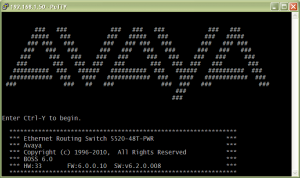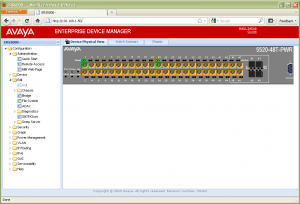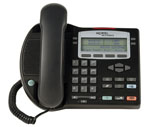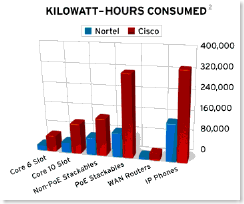 Avaya has released software 6.2.0 for the Ethernet Routing Switch 5500/5600 series switches. In order to upgrade to 6.2 software the switch will already need to be running 6.x software along with firmware (diagnostic software) 6.0.0.6. Switches that are running older software will need to first be upgraded to 6.0 and then to 6.2 software.
Avaya has released software 6.2.0 for the Ethernet Routing Switch 5500/5600 series switches. In order to upgrade to 6.2 software the switch will already need to be running 6.x software along with firmware (diagnostic software) 6.0.0.6. Switches that are running older software will need to first be upgraded to 6.0 and then to 6.2 software.
Please review the release notes for all the details.
Here are some of the new features;
- Enterprise Device Manager
- 802.1AB (LLDP) MED Network Policy
- 802.1X authentication and Wake on LAN
- 802.1X or Non-EAP and Guest VLAN on same port
- 802.1X or Non-EAP Last Assigned RADIUS VLAN
- 802.1X or Non-EAP with Fail Open VLAN
- 802.1X or Non-EAP with VLAN name
- Autodetection and Autoconfiguration (ADAC) Uplink Enhancements
- Automatic QoS 802
- Automatic QoS and ADAC Interoperability
- Cisco CLI commands
- Content-based forward to next hop (formerly source address-based route selection)
- DHCP enhancements
- DHCP option 82 support
- Dual Syslog Server support
- EAP/NEAP separation
- Energy Saver
- Enhanced QoS engine
- Filter Limiting
- Full IGMPv3
- IPv4 Tunneling for IPv6
- IPv6 Automatic Address Assignment
- IPv6 Routing DHCP Relay
- IPv6 Static Routing
- MAC Security enhancement
- Multicast group scaling
- Multiple Hosts with Multiple VLANs for EAP-enabled Ports
- PIM-SM support
- Port Mirroring – Bi-directional monitor port
- QoS DSCP mutation
- QoS Egress Queue Shaping
- QoS Lossless Buffering Mode for Data Center Applications
- Route scaling
- Running configuration NNCLI display command enhancements
- Secure Shell File Transfer Protocol (SFTP over SSH)
- SFP support
- Split Multi-link Trunk (SMLT) consistency with the Ethernet Routing Switch 8600
- Split Multi-link Trunk (SMLT) over Link Aggregation Control Protocol (LACP)
- Trace command
- Unicast storm control
- VLAN Scaling
Here are some of the issues that have been resolved in this release;
- Q01219391 MAC Address table does not age out all MAC sources learned after the aging time has expired.
- Q01470123 Passive static device behind a phone displayed as unknown after switch reboot.
- Q01470123-01 Passive static device behind a phone displayed as unknown after switch reboot.
- Q01728560 ADAC port configuration types not defined in manual.
- Q01775378 Error message when disabling spanning tree learning.
- Q01859874 Typed commands should not be sent remotely when log level is serious or critical.
- Q01860782 A message is needed to confirm the successful upload of an ASCII configuration to USB with the PUSH button.
- Q01862906 The Time Domain Reflectometer in the JDM displays an incorrect message for the Pin Short cable error.
- Q01863512 MAC security Lifetime setting cannot be modified from the JDM.
- Q01865091 MAC authorized clients are not reauthorized after a former base unit reenters the stack.
- Q01895467 Some LLDP commands fail when configuring a device with an ASCII configuration file.
- Q01895723 Metric for external routes jumps to 127174722 when a dummy vlink is created and deleted.
- Q01906362 An NEAP client can change ports without a link down or age out timer event.
- Q01909890 QoS-IGMP problems with known and unknown multicast options on 56xx ports.
- Q01901336 Multicast traffic not forwarded through non-local static routes.
- Q01923408-02 Management VLAN IP address should always be used in relation to RADIUS.
- Q01927698 PIM interfaces become disabled on a device.
- Q01938607 Incorrect error message displayed during software download from an unreachable server.
- Q01942783 Restoring a device with an ASCII configuration file fails when Layer 3 settings are present.
- Q01943527 Inconsistency between IPv4 and IPv6 in binary configuration file.
- Q01945909 Some ARP, OSPF, or VRRP packets are unexpectedly mirrored when using XrxYtx mirroring mode and the monitored port is in the Management VLAN or in SMLT VLANs.
- Q01946214 MAC addresses are lost when a base unit fails.
- Q01946284 LLDP-Med does not work in certain circumstances
- Q01947050 ADAC system message logged after a stack is reset.
- Q01948343 On a pure 56xx stack, port mirroring mode XrxYtx multiplies unicast traffic on port Y in certain scenarios.
- Q01950071 VLACP enabling does not work in some circumstances.
- Q01950147 The EAP-TLS or PEAP-MsChapV2 clients could be unexpectedly transitioned to the EAP Held state on a multihost enabled port.
- Q01950311 Voice traffic is blocked on a non-base unit when ARP inspection is enabled on a VoIP VLAN.
- Q01951600 Error performing MIB walk on 5632.
- Q01954041 LLDP Med-Network-Policies Voice Tagging command issue.
- Q01955272 PIM OIF may not get installed on IR.
- Q01956922 Continuous IPv6 ping out stops working after 2147 ICMPv6 messages.
- Q01978465 Telnet session hangs on ERS 5510-48T during an ASCII configuration download.
- Q02005019 ACG will fail when ports are added to VLANs if an STG was created, VLANs were added, the STG enabled and then ports added to VLANs (configuration control flexible and 1 port in 2 different VLANs).
- Q02020938 After booting to default settings the syslog will display the message ASCII failed at line 1. This can be ignored. This only happens after a boot to default settings and not during a normal operation or reset of the switch. This does not affect subsequent ASCII downloads. The successful application of configurations can be confirmed using the show logging command. The bogus message will be the first in chronological order.
I would highly recommend you review the release notes for all the details. There are a lot of known issues that should be thoroughly reviewed before you made any decisions about upgrading.
There was one section that caught my eye on page 11 of the release notes;
Currently when ADAC is operational, a user can not change the non-ADAC VLANs on the port (without disabling ADAC, changing the VLAN and then re-enabling ADAC), which leads to usability issues that limit the deployment of ADAC.
The ADAC enhancements provide the ability to change the non-ADAC VLANs on a port irrespective of the ADAC status of the port. Any such changes in the underlying port VLAN assignment are saved as normal to NVRAM and ASCIII configurations.
I posted about this issue with ADAC way back in August of 2008. This one issue has been a real bear and the only real issue we’ve experienced with our ADAC deployments. While it might be the only issue, it can create some enormous problems if the engineers are following the procedure to disable ADAC, make the VLAN change and then enable ADAC again. I’ll be very interested to see if this problem is finally resolved.
I spent a few minutes playing with Enterprise Device Manager but I think this change will drive more folks to the CLI interface where Avaya/Nortel has alot of work to-do. I’m also excited to see that Avaya/Nortel is finally bringing together their Automatic QoS and ADAC features, I’m curious to see what changes they’ve made an how I might be able to tweak my switch configurations to better automate the deployment of IP telephony.
Cheers!

 We’re preparing to deploying 300+ i2002/i2004 IP telephones over the next few weeks. In preparation for this deployment we decided to upgrade the current IP phone firmware from 0604DBG to 0604DCG. The site has a Nortel Succession 1000M Call Server with 3 Succession Remote Gateway (SRG) 50s providing local PSTN and E-911 services at three remote facilities. We have done this dozens of times in multiple locations and never really had an issue (except when ‘
We’re preparing to deploying 300+ i2002/i2004 IP telephones over the next few weeks. In preparation for this deployment we decided to upgrade the current IP phone firmware from 0604DBG to 0604DCG. The site has a Nortel Succession 1000M Call Server with 3 Succession Remote Gateway (SRG) 50s providing local PSTN and E-911 services at three remote facilities. We have done this dozens of times in multiple locations and never really had an issue (except when ‘